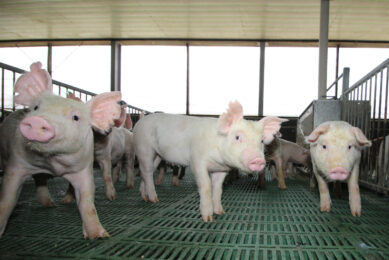Artificial insemination done differently

Bright pink and purple – those are the colours of Absolute Swine Insemination. Not only in its looks does the company position itself as different. At the 10 year anniversary of its one-shot post-cervical insemination catheter, inventor Mark Anderson looks back.
By Vincent ter Beek
“Just look at Apple computers. In the beginning it was mainly mediagraphics people who used their technology, but we all know how that changed with Apple becoming one of the most popular companies in the world. I think we also could be following that same path with Absolute Swine Insemination. I know that those who use our catheters wouldn’t give it up for anything. But those who find change difficult to accept, resist using them.
We launched this product in a time when there was no Ovugel and no sexed semen. There was no concept to reduce the total amount of semen cells to 1 billion, or even 500 million – and still be potentially ready for single dose inseminations. And although our catheters are not magic wands, in well managed farms with good genetics, heard health, spot-on-timing, and excellent staffing, it works consistently. We were ten years ahead of our time.
Traditional inseminations, using a normal foam tip or spiral catheters, deliver semen into the cervix while the sow is in standing heat. The sows have to draw the semen through the catheter into the cervix – contracting movements take care of that.
A lot of people think that the more semen one puts into a cervix, the more semen will get into the uterus. Certainly, semen survives – but semen does not have a brain. Helped by cilia and flagella, it swims up the horn rather slowly.
The cervix is designed to keep foreign bodies out. The cervix secretes fluids that kill foreign bodies, including semen – and the uterine horns do as well; this process is called ‘phagocytosis’. When semen does make it through the cervix, into the uterus, and then up to the utero-tubal junction, up to 98% of the genetic material can die during the journey. This journey can vary in length from 12 inches (30 cm, ed.) to several feet, depending on the parity.”
Post-cervical insemination
Post-cervical insemination, also known as Intra-Uterine Insemination, was invented 12 years ago – the approach has not changed much since then. The method is very invasive as basically, it works with an outer tube, and an extendable inner tube and better lubrication.
With the concept, there is an inherent risk of scraping the cervical wall, which can cause infection. Therefore the method requires training.
There are other complications with post-cervical insemination. Damaging the horns can lead to scar tissue and this can get infected – cysts can occur. Now what happens if a technician locks a catheter in, in such a case? He will notice an obstruction and will wonder: ‘What is stopping it? Should I push harder or should I pull out?’
A lot will push harder. When pinching any obstruction or cyst, this may lead to infertility – or worse, he may kill the animal.
There is one more thing. The tube will have to go through the vaginal cavity, and the foam tip is at the very end of the catheter. Apart from lubricant, it will carry all kind of muck. The second inner tube will take these bacteria right to the place where you don’t want to have them.Even if the post-cervical insemination would work, you’ll still have to sit and wait for the animal to draw in the semen. The semen will have to travel to the uterine horns. It may take two to eight hours. All this time fluids can do their work leading to phagocytosis.
Deep IUI
Deep Intra-uterine insemination (Deep IUI) is an ungodly process nobody uses. It consists of one single small flexible tube of 1.5 m long. It is shoved through the cervix and uterus until it stops in one of the horns. There, a very small amount of semen (10-15 ml) is deposited in only one of the horns. In one horn – half of the eggs are on the other side. The semen is not going to take a trip to the other side by itself!
Another objection: This method can really only be implemented by a vet. Nobody in their right mind would do this. Think of what would happen to litter size! You use only half of her pregnancy ability. And again – why risk this method? If you damage something, you may render her sterile.
Combination
The Absolute catheter combines deep AI with post-cervical AI in a one-piece catheter that anybody can use safely. The solution, covered by 28 patents, is both effective and economical. It comes in a purple one for gilts, with a membrane length of 4.5 inches (11 cm, ed.); and a pink one for sows with a membrane length of 6.5 inches (17 cm, ed.).
Indeed, there will also be muck of the maternal cervix on these foam tips. It can be solved though. The catheter is equipped with a membrane inside, which folds out like pulling out a sock inside out when pressure is given, right at the front of the catheter.
Anyone who’s done classical AI has been told: ‘Don’t squeeze the container – you will kill the semen. And you will have backflow, as everything will be falling back on the floor.’ In our case, one has to squeeze. It works hydraulically, to empty the membrane. It’s 180 degrees different from what others have been targeting – and it will take only 30 seconds to one minute.
In case of an obstruction, the membrane provides a solution as well, as it can expand like a balloon, thus opening a pathway by widening the cervical canal. Semen will get a way to go around the obstruction.
In addition, the semen does not have to rely on the cilia to travel through the uterine horns. The semen is injected hydraulically, directly to the utero-tubal junction.
Latex
The membrane is made of latex. In the beginning the general reaction was: ‘That won’t work. Latex kills semen.’ Yes, it does – but here’s the thing: There are different types of latex – it’s all about the compounding agents used in the formulation. Our agents have been the most sperm-friendly. In addition, the semen is being injected so fast, that it barely touches the latex. So was our approach a big success from the start? Yes and no. When I invented it, I encountered a lot of animosity. I wasn’t one of them from the pig industry; I was a Silicon Valley yuppie.
There was this problem of how to inseminate pigs; and here I came along. I didn’t have a farm, I didn’t have animals. I approached a number of big integrators and universities. Everybody slammed the door shut.
Luckily I knew a lot of people in the Philippines and in China. For a research project I told them – we’ll give them for free. Then all doors opened up. We did trials there for two to three years to develop the proper usage techniques of this profound delivery system. In the past 2.5 billion semen cells were added per dose. One billion to 500 million cells per dose is now possible.
British breeder JSR and ACMC have been working with us for the last nine or so years; a number of Topigs units use our products and PIC has performed research too. Our biggest markets are the USA and Japan – and we export from our manufacturing plants in China globally.
The catheter recently celebrated its ten-year anniversary. Since the introduction, only slight design changes, to reduce manufacturing costs, needed to be made.”
BIOGRAPHY
Before embarking on the Absolute Swine mission, Mark Anderson, 56, had an extensive manufacturing background in Silicon Valley. As owner of a precision turnkey manufacturing company during 1978-1999, Anderson worked directly with the likes of Steve Jobs (Apple Computer/ Next Computer), Nolan Bushnell (Atari/ Senté Technologies/ Pizza Time Theater), and Scott McNealy (Sun Microsystems) by playing a role in designing and fabrication. Company projects included computers, medical devices, military and department of defense contracts.











